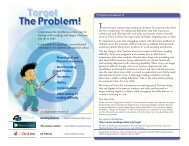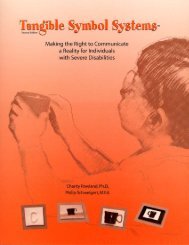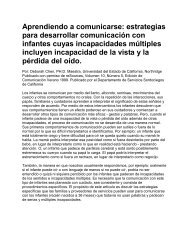ACCOMMODATIONS MANUAL - The Office of Special Education ...
ACCOMMODATIONS MANUAL - The Office of Special Education ...
ACCOMMODATIONS MANUAL - The Office of Special Education ...
Create successful ePaper yourself
Turn your PDF publications into a flip-book with our unique Google optimized e-Paper software.
<strong>ACCOMMODATIONS</strong> CONDITIONS<br />
VISUAL PRESENTATION <strong>ACCOMMODATIONS</strong><br />
Standard<br />
Nonstandard<br />
Instruction only<br />
Large Print<br />
Large print editions <strong>of</strong> tests and instructional materials are required for some students with<br />
visual impairments. It is recommended that regular print materials be manipulated to reformat<br />
test items and enlarge or change the font as needed. All text and graphic materials—including<br />
labels and captions on pictures, diagrams, maps, charts, exponential numbers, notes, and<br />
footnotes—must be presented in at least 18-point type for students who need large print.<br />
Students, working with their teachers, need to find an optimal print size and determine the<br />
smallest print that can still be read. (Copyright issues may need to be addressed). It is<br />
important for the print to be clear, with high contrast between the color <strong>of</strong> the print and the<br />
color <strong>of</strong> the background. When using large-print classroom material, consider the weight, size,<br />
and awkwardness <strong>of</strong> books. Large-print books are now available that look very similar to the<br />
same books in standard print.<br />
Magnification Devices<br />
Some students with visual impairments read regular print materials and enlarge the print by<br />
using magnification devices. <strong>The</strong>se include eyeglass-mounted magnifiers, free standing or<br />
handheld magnifiers, enlarged computer monitors, or computers with screen enlargement<br />
programs. Some students also use Closed Circuit Television (CCTV) to enlarge print and<br />
display printed material with various image enhancements on a screen.<br />
Sign Language<br />
Sign language interpreters may be required for students who are deaf or hard <strong>of</strong> hearing.<br />
Sometimes an interpreter is only needed or allowed to sign instructions and to assist in<br />
communication. Some students may need all print materials interpreted while learning to read<br />
print. Interpreters need to be able to translate in the same method <strong>of</strong> sign language typically<br />
used by the student (e.g., American Sign Language, Cued Speech). Interpreters must not<br />
paraphrase, clarify, elaborate, or provide assistance with the meaning <strong>of</strong> words, intent <strong>of</strong> test<br />
questions, or responses to test items. Graphic materials may be described but should also be<br />
available in print or tactile formats. A standard video presentation <strong>of</strong> a test in sign language<br />
may be used to increase quality, consistency, pacing, and accuracy.<br />
26





